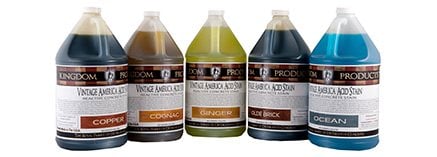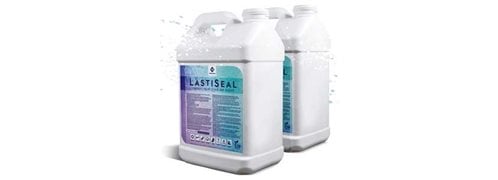- Concrete Stain Home
- Get the Look - Stained Floor Pictures
- Color Chart: Concrete stain colors
- Comparison Chart: Compare acid stains, water-based stains and dyes
- Stain Buying Tips: Questions to ask before you buy
- How to Stain Concrete
- Types of Stains and Coloring Options
- Acid-Based Stains
- Water-Based Penetrating Stains
- Concrete Dyes
- Concrete Paint
- Exterior Concrete Stain: Click through images of outdoor stained concrete projects
- Stains and Equipment Product Reviews
- Troubleshooting Concrete Stains
- Common Staining Issues: Tips from expert Chris Sullivan
- Removing Stains from Concrete
Water-Based Concrete Stain Problems
Flaking sealer caused by overapplication of stain- Question:
-
The concrete floor in our LEED-Silver-certified office building was finished with a leading manufacturer's water-based stain and then sealed with a different manufacturer's sealer, followed by the application of two coats of wax. Construction took place in December 2008, and the building opened for use in March 2009. After a couple of months, the stain and sealer began flaking off and scratching away under chair legs. A duct-tape test confirmed that the finish was readily pulling off.
The floor finishing contractor returned in December 2009 to strip the wax and sealer and reapply stain and sealer from the same manufacturer's system. The floor finish appearance was improved in the short term, but has since worn off. A duct-tape test about two months after the refinish work pulled up colored stain material. The finish also continues to have an uneven, or "crazed," appearance after washing with a mild pH cleanser, both when it is wet and after drying.
The construction contractor believes that the concrete floor was installed correctly to accept a stain, because it was allowed to cure about six months before application of the stain and sealer and protected until the work was done. Note that the temperature at the jobsite was probably below freezing at the time of the floor finish work. What factors would contribute to the failure of the finish, even after reapplication?
- Answer:
-
Typically failures like these are caused by a combination of factors, not just one. From your email description, it sounds like the stain never really penetrated into the concrete and is acting like a bond breaker to the sealer. The fact that the tape test pulled off sealer and stain indicates that the weak link is the stain.
Water-based stains are nonreactive and rely solely on the porosity of the concrete to penetrate and hold the color. If the concrete is not porous, the stain will simply lay on the surface. The other more likely possibility is overapplication of the stain. If a water-based stain is overapplied, the surface tension of the water tends to keep the stain on the surface. When the water evaporates, it leaves a high concentration of stain residue, which acts like a bond breaker when the sealer is applied.
Temperature is another major factor when applying stain to concrete. Industry standards for applying any type of topical stain and sealer system is a minimum of 50 F and maximum of 90 F. Cold temperatures cause the concrete pores to contract and water to condense and even freeze. Cold temperatures also slow the chemical process and can keep stains and sealers from penetrating and forming their respective chemical structures.
To help determine the cause of the failure, you should ask these questions:
Were test sample areas performed prior to application of the final finish?
What is the finish of the concrete – smooth, rough, hard troweled, burnished?
Was a water test performed to determine the porosity of the concrete prior to stain application? (Water sprayed on the concrete should wet out the surface in under three seconds.)
What was the square foot coverage of the stain when applied? Most water-based systems should get a minimum coverage rate of 300 square feet per gallon, and some even cover up 500 to 600 square feet.
Keep in mind that water-based stains are nothing more than a coloring agent (such as an acrylic, metal complex, or iron oxide) dispersed and suspended in water or saltwater. There might be small amount of thickener and polymer in the stain to aid in adhesion, but not much else. For these stains to work, they must be applied very thinly, and the concrete must be dry and at the right temperature to readily absorb the stain
In my opinion, the first finish failed due to a combination of cold temperatures and overapplication of the stain. The second repair application failed because not enough of the first application was removed. I usually recommend mechanical grinding to ensure that all the material is removed before attempting reapplication.
Learn more about how to buy concrete stains.
Return to How to Fix Concrete Acid Stains
 Vintage America Acid Stain
Organic, antique patina, deep penetrating reactive stain.
Vintage America Acid Stain
Organic, antique patina, deep penetrating reactive stain.
 Acid Stain by Surfkoat
Makes up to 2 gallons. Great for marble look.
Acid Stain by Surfkoat
Makes up to 2 gallons. Great for marble look.
 Stain-Crete by Increte
9 standard colors. Useful for old or new concrete.
Stain-Crete by Increte
9 standard colors. Useful for old or new concrete.
 Elements® Transparent Concrete Stain
Water-based, environmentally and user-friendly
Elements® Transparent Concrete Stain
Water-based, environmentally and user-friendly
 Concrete Stain + Sealer in One
Waterproof, strengthen, preserve and beautify in one step
Concrete Stain + Sealer in One
Waterproof, strengthen, preserve and beautify in one step
 Stone Tone Stain
10 color options. Resistant to chipping and fading.
Stone Tone Stain
10 color options. Resistant to chipping and fading.
 Concrete Acid Stain
BRICKFORM Blush-Tone Acid Stain available in 10 standard colors
Concrete Acid Stain
BRICKFORM Blush-Tone Acid Stain available in 10 standard colors
 In-Fluence Water-Based Stain
24 non-reactive colors that transform concrete.
In-Fluence Water-Based Stain
24 non-reactive colors that transform concrete.




